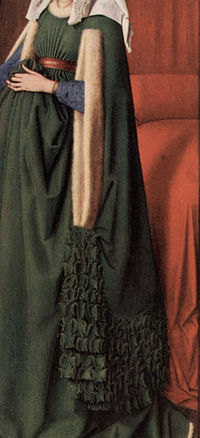Sleeve

An elaborate hanging sleeve of the 15th century: Detail of The Arnolfini Portrait by Jan van Eyck.
Sleeve (O. Eng. slieve, or slyf, a word allied to slip, cf. Dutch sloof) is that part of a garment which covers the arm, or through which the arm passes or slips. The pattern of the sleeve is one of the characteristics of fashion in dress, varying in every country and period. Various survivals of the early forms of sleeve are still found in the different types of academic or other robes. Where the long hanging sleeve is worn it has, as still in China and Japan, been used as a pocket, whence has come the phrase to have up one's sleeve, to have something concealed ready to produce. There are many other proverbial and metaphorical expressions associated with the sleeve, such as to wear one's heart upon one's sleeve, and to laugh in one's sleeve.
Sleeve length varies from barely over the shoulder (cap sleeve) to floor-length, Most contemporary shirt sleeves end somewhere between the mid-upper arm and the wrist.
Types of sleeves
Often the names applied to sleeves in historical costume are modern.
- Batwing sleeve, a long sleeve with a deep armhole, tapering towards the wrist. Also known as a "magyar" sleeve.
- Bell sleeve, a long sleeve that is fitted from the shoulder to wrist and gently flared from wrist onward. The bell sleeve is very similar to the poet sleeve, but has a "cleaner look," often without ruffles.
- Bishop sleeve, a long sleeve, fuller at the bottom than the top, and gathered into a cuff (1940s)
- Butterfly sleeve, usually found on dresses or formal blouses that start at the shoulder and get wider toward the end of the sleeve, but usually don't go longer than 4-5 inches. The difference between a butterfly sleeve and a Bell sleeve is that butterfly sleeves usually don't go completely around the full arm[citation needed].
- Cap sleeve, a very short sleeve covering only the shoulder, not extending below armpit level
- Dolman sleeve, a long sleeve that is very wide at the top and narrow at the wrist
- Gigot sleeve or leg of mutton sleeve, a sleeve that is extremely wide over the upper arm and narrow from the elbow to the wrist
- Hanging sleeve, a sleeve that opens down the side or front, or at the elbow, to allow the arm to pass through (14th, 15th, and 16th centuries.)
- Juliette sleeve, a long, tight sleeve with a puff at the top, inspired by fashions of the Italian Renaissance and named after Shakespeare's tragic heroine; popular from the Empire period through the 1820s in fashion, again in the late 1960s under the influence of Zeffirelli's film
- Pagoda sleeve, a wide, bell-shaped sleeve popular in the 1860s, worn over an engageante or false undersleeve
- Paned sleeve, a sleeve made in panes or panels, allowing a lining or shirt-sleeve to show through (16th and 17th centuries)
- Poet sleeve, a long sleeve fitted from shoulder to elbow, and then flared (somewhat dramatically) from elbow to wrist (or sometimes mid-hand). Often features ruffles on the cuffs.
- Puffed or puff sleeve, a short, ¾ length or full sleeve that is gathered at the top and bottom, now most often seen on wedding and children's clothing
- Raglan sleeve, a sleeve that extends to the neckline
- Set-in sleeve, a sleeve sewn into an armhole (armscye)
- Two-piece sleeve, a sleeve cut in two pieces, inner and outer, to allow the sleeve to take a slight "L" shape to accommodate the natural bend at the elbow without wrinkling; used in tailored garments
- Virago sleeve, a full "paned" or "pansied" sleeve gathered into two puffs by a ribbon or fabric band above the elbow, worn in the 1620s and 1630s.
- 1/4 Length Sleeve, a sleeve which extends from the shoulder to mid-way down the biceps and triceps area.
- 3/4 Length Sleeve, a sleeve which extends from the shoulder to a length mid-way between the elbow and the wrist. It was common in the United States in the 1950s and again 21st century.
References
This article includes a list of references, related reading, or external links, but its sources remain unclear because it lacks inline citations. (August 2009) |
- Oxford English Dictionary
- Picken, Mary Brooks: The Fashion Dictionary, Funk and Wagnalls, 1957.

